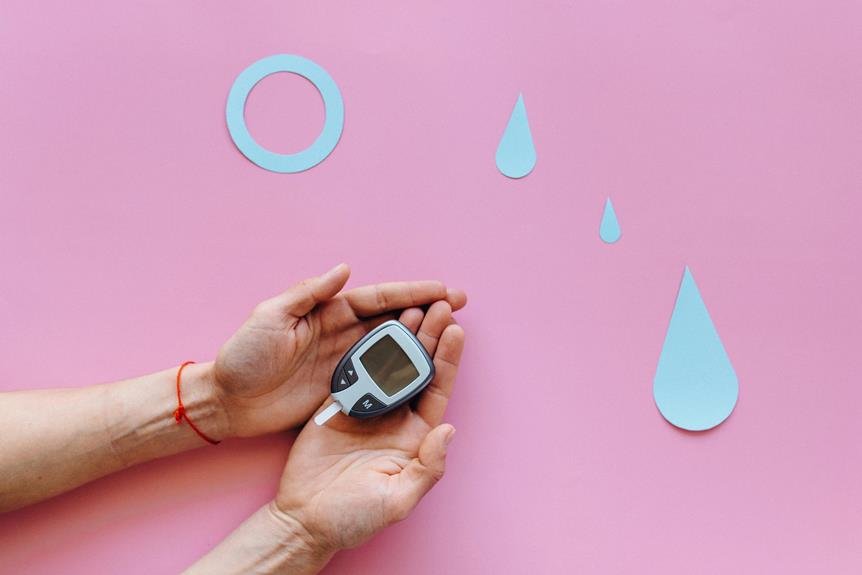Diagnosing Diabetes Neuropathy: Tests and Procedures
When it comes to uncovering the complexities of diabetes neuropathy, various tests and procedures serve as essential tools in assisting healthcare providers to pinpoint the condition's presence.
From the familiar neurological examination to more sophisticated methods like nerve conduction studies and EMG, the diagnostic process offers a range of insights into the extent of nerve damage.
However, there is one particular test that can offer unique information that may surprise you, shedding light on aspects that other tests might overlook.
Neurological Examination
When assessing for diabetes neuropathy, it is essential to begin by conducting a thorough neurological examination. This examination involves evaluating sensory function, muscle strength, reflexes, and coordination.
Sensory function tests can include assessments for pain, temperature, vibration, and proprioception to identify any abnormalities that may indicate nerve damage. Testing muscle strength helps determine if there's any weakness or atrophy present, which can be indicative of neuropathy.
Reflex testing examines the responses of deep tendon reflexes, such as the knee jerk reflex, to assess the integrity of the nerve pathways. Coordination tests, like finger-to-nose and heel-to-shin maneuvers, are essential for detecting any impairments in motor function that may result from neuropathy.
Additionally, assessing for autonomic neuropathy symptoms, such as changes in heart rate, blood pressure, and sweating patterns, can provide further insights into the extent of nerve damage.
Nerve Conduction Studies
Nerve conduction studies play a crucial role in evaluating nerve function and diagnosing diabetes neuropathy. During these studies, electrodes are placed on your skin, and small electrical impulses are used to measure the speed at which nerves transmit signals. This test helps determine if there's any nerve damage present, which is common in diabetes neuropathy. By measuring the speed of nerve signal transmission, healthcare providers can pinpoint the location and extent of nerve damage.
Nerve conduction studies are particularly useful in differentiating between different types of neuropathy and assessing the severity of nerve damage. This information is vital for developing an effective treatment plan and monitoring the progression of the disease. The results of these studies can help determine the best course of action to manage symptoms and prevent further complications associated with diabetes neuropathy.
Electromyography (EMG)
When undergoing Electromyography (EMG), the procedure involves measuring nerve signals in your body.
This diagnostic test helps healthcare providers assess nerve function and detect potential issues.
EMG is a crucial tool in identifying and understanding diabetes neuropathy.
EMG Procedure Overview
During an EMG procedure, electrodes are used to measure the electrical activity in your muscles. These electrodes are placed on your skin or inserted into the muscle, depending on the area being examined. When the muscles contract, they produce electrical signals that are detected by the electrodes. The EMG machine records these signals, which can help identify abnormal muscle function.
You may experience some discomfort during the procedure, such as a sensation similar to a pinprick when the electrodes are inserted. The test is relatively quick and provides valuable information to your healthcare provider about the health of your muscles and nerves. Following the EMG, your healthcare provider will analyze the results to assist in diagnosing any potential issues with muscle function.
Nerve Signal Measurement
To measure the electrical activity in your muscles, electrodes are utilized during an Electromyography (EMG) procedure. This test helps assess the health of your nerves by recording the signals they send to your muscles.
During an EMG, small needles are inserted into the muscles being tested. These needles detect the electrical activity when your muscles contract and rest. The patterns of electrical activity captured by the electrodes provide valuable information about the functioning of your nerves.
Abnormalities in these signals can indicate nerve damage or dysfunction, which is crucial in diagnosing conditions like diabetic neuropathy. By analyzing the nerve signal measurements obtained from an EMG, healthcare providers can better understand the extent and nature of nerve impairment.
Diagnostic Nerve Testing
Electromyography (EMG) is an essential diagnostic tool for assessing nerve health by measuring the electrical activity in muscles. During an EMG test, small needles are inserted into the muscle to record its electrical activity at rest and during contraction. This test helps identify nerve damage by evaluating how well the muscles respond to nerve signals.
EMG can pinpoint the location of nerve dysfunction and determine the severity of nerve damage in individuals with diabetes neuropathy. It's a valuable tool for healthcare providers to diagnose diabetic neuropathy early, allowing for timely intervention to manage symptoms and prevent further complications.
If you're experiencing symptoms like numbness, tingling, or weakness, your healthcare provider may recommend an EMG to assess your nerve function accurately.
Autonomic Testing
Let's explore the significance of autonomic testing in diagnosing diabetes neuropathy.
These tests can provide valuable insights into the functioning of your autonomic nervous system, which controls involuntary bodily functions like heart rate and digestion.
Understanding the different types of autonomic tests and their diagnostic value is crucial for a comprehensive evaluation of diabetes-related nerve damage.
Test Types
Autonomic testing assesses the function of the autonomic nervous system, which controls involuntary bodily functions. This type of testing helps evaluate how well your body regulates processes like heart rate, blood pressure, digestion, and sweating.
One common autonomic test is the deep breathing test, where you inhale and exhale according to specific patterns while your heart rate and blood pressure are monitored. Another test measures how your body responds to changes in posture, assessing blood pressure and heart rate variability when moving from lying down to standing up.
These tests provide valuable insights into the health of your autonomic nervous system and can aid in diagnosing conditions like diabetic neuropathy.
Diagnostic Value
Curious about how autonomic testing can aid in diagnosing conditions like diabetic neuropathy?
Autonomic testing plays a crucial role in evaluating the function of the autonomic nervous system, which can be affected in diabetic neuropathy.
By measuring responses such as heart rate variability, blood pressure changes, and sweating patterns, autonomic testing provides valuable insights into the health of this system.
These tests can help identify early signs of autonomic dysfunction before symptoms manifest, allowing for prompt intervention and management.
Blood Tests
To diagnose diabetes neuropathy, blood tests are essential for assessing nerve damage and monitoring your condition. These tests can measure your blood sugar levels, hemoglobin A1c, and glucose tolerance to evaluate how well your body is managing diabetes. Elevated blood sugar levels over time can lead to nerve damage, so it's crucial to keep these levels in check through proper management of your diabetes.
Additionally, blood tests can detect specific biomarkers associated with nerve damage, providing valuable insights into the extent of neuropathy you may be experiencing.
Furthermore, blood tests can help identify any deficiencies in essential nutrients like vitamin B12, which are important for nerve health. Deficiencies in these nutrients can exacerbate neuropathy symptoms, making it vital to address any imbalances through dietary changes or supplements.
Regular blood tests can also track your progress and determine the effectiveness of your treatment plan, allowing healthcare providers to make necessary adjustments to optimize your neuropathy management.
Imaging Tests
Imaging tests play a crucial role in diagnosing diabetes neuropathy by providing detailed insights into nerve damage and its progression. These tests allow healthcare providers to visualize the nerves and identify any abnormalities that may be present. One common imaging test used for diagnosing diabetes neuropathy is a nerve conduction study (NCS). During an NCS, electrodes are placed on the skin to measure the speed at which electrical impulses travel through the nerves. Slower nerve conduction speeds can indicate nerve damage caused by diabetes.
Another imaging test that can be beneficial in diagnosing diabetes neuropathy is magnetic resonance imaging (MRI). An MRI scan can provide detailed images of the nerves and surrounding tissues, helping healthcare providers to assess the extent of nerve damage and plan appropriate treatment strategies.
Additionally, ultrasound imaging may also be used to visualize the nerves and detect any structural changes that could be contributing to neuropathic symptoms. By utilizing these imaging tests, healthcare providers can accurately diagnose diabetes neuropathy and develop personalized treatment plans to manage the condition effectively.
Skin Biopsy
To further evaluate nerve damage in diabetes neuropathy, consider undergoing a skin biopsy, which can provide valuable insights into the condition. During a skin biopsy, a small piece of skin is removed from the affected area, usually the leg. This procedure helps in evaluating the density of nerve endings in the skin, which can indicate the extent of nerve damage present. By examining the skin sample under a microscope, healthcare providers can identify any abnormalities in the nerve fibers, such as nerve degeneration or loss.
Skin biopsies are particularly useful in diagnosing small fiber neuropathy, a type of nerve damage common in diabetes. This type of neuropathy can be challenging to detect through other diagnostic tests, making a skin biopsy a valuable tool in confirming the presence of nerve damage. Additionally, the information obtained from a skin biopsy can aid in determining the appropriate treatment and management strategies for diabetes neuropathy. Consider discussing the option of a skin biopsy with your healthcare provider to further evaluate your condition and develop an effective care plan.
Nerve Biopsy
Consider undergoing a nerve biopsy to provide a more in-depth assessment of nerve damage in diabetes neuropathy. During a nerve biopsy, a small piece of nerve tissue is removed for examination under a microscope. This procedure allows for a direct evaluation of the nerve fibers, identifying any abnormalities or damage present. Nerve biopsies are particularly useful in cases where other diagnostic tests haven't provided conclusive results or when a more detailed analysis is required.
The biopsy procedure is usually performed under local anesthesia, involving a small incision to access the nerve. Although nerve biopsies are considered safe, some risks like infection or prolonged numbness at the biopsy site may occur. After the procedure, the nerve tissue sample is sent to a laboratory for analysis by a pathologist. The results of the nerve biopsy can help determine the extent of nerve damage, the specific type of neuropathy present, and guide treatment decisions.
Frequently Asked Questions
Can Diabetes Neuropathy Be Reversed or Cured With Treatment?
Yes, diabetes neuropathy can be managed with proper treatment to alleviate symptoms and slow progression. While it may not be completely reversed or cured, early intervention and lifestyle changes can significantly improve your quality of life.
Are There Any Alternative or Complementary Therapies That Can Help Manage Diabetes Neuropathy Symptoms?
When managing diabetes neuropathy symptoms, consider alternative therapies like acupuncture or supplements. While not substitutes for medical care, they can complement traditional treatments. Prioritize consulting healthcare providers to ensure comprehensive care.
How Can Lifestyle Changes, Such as Diet and Exercise, Impact the Progression of Diabetes Neuropathy?
You can improve diabetes neuropathy by embracing a healthy lifestyle. Regular exercise and a balanced diet can slow its progression. Consistent physical activity and nutritious eating habits play a crucial role in managing and potentially reducing symptoms.
Are There Any Specific Risk Factors or Genetic Predispositions That Make Someone More Likely to Develop Diabetes Neuropathy?
If you're wondering about specific risk factors or genetic predispositions for diabetes neuropathy, yes, some individuals are more likely to develop it due to family history or poorly controlled blood sugar levels.
Can Diabetes Neuropathy Impact Other Areas of the Body Beyond the Nerves, Such as Muscles or Organs?
Yes, diabetes neuropathy can impact various areas beyond nerves. It may affect muscles, causing weakness or atrophy. Organs like the heart, digestive system, and sexual organs could also be influenced, leading to complications.
Conclusion
So, if you suspect you may have diabetes neuropathy, it's important to undergo a variety of tests and procedures to accurately diagnose the condition.
These tests can provide valuable insight into the extent of nerve damage and help determine the best course of treatment.
Remember, knowledge is power when it comes to managing your health, so don't hesitate to seek out professional medical advice.
Your journey to understanding your body's signals is like a winding road of discovery – embrace it.






